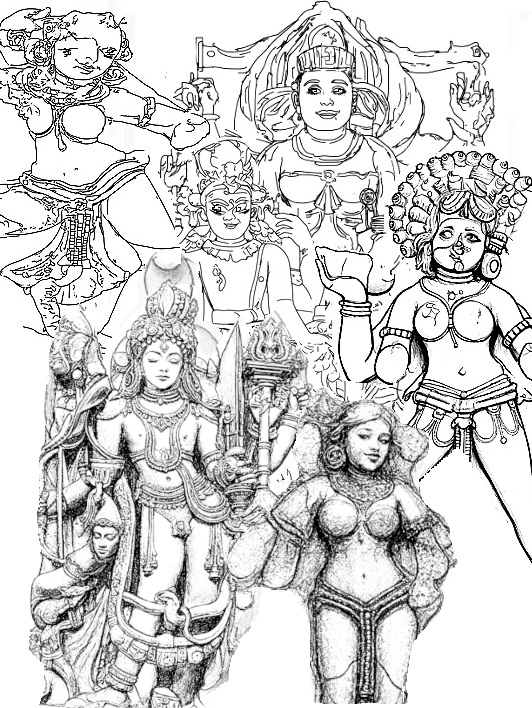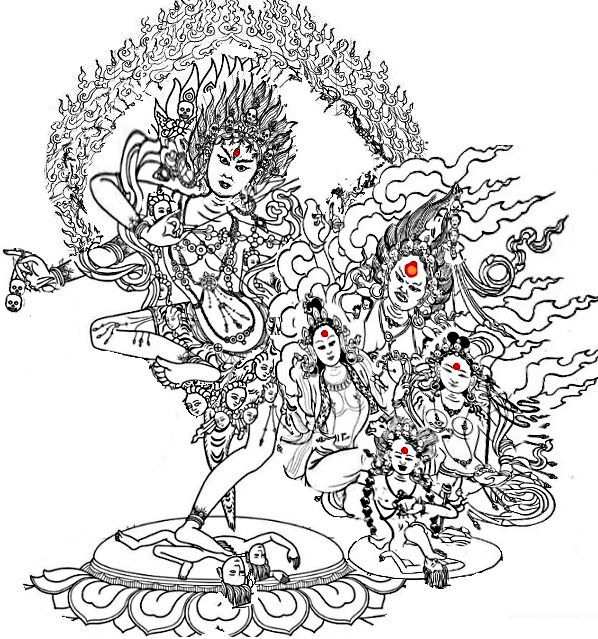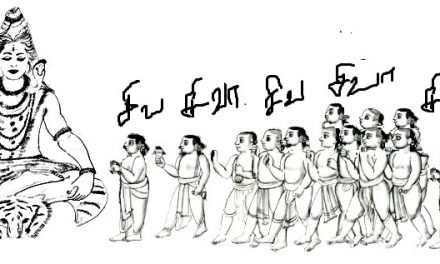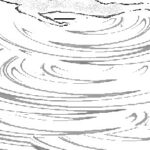64 Yoginis
Santhipriya

64 Yoginis
According to the Puranic texts in Hinduism, Adi Parasakthi, while in the form of Sati, manifested eight female deities called Ashta Matrikas. According to Kaula Tantra school of thought the eight Ashta Matrikas were Brahmani, Vaishnavi, Maheshwari, Indrani, Kaumari, Varahi, Chamunda and Narasimhi. The central theme of Kaula Tantra is to guide people toward spiritual liberation and the attainment of the highest state of consciousness, which is considered supreme wisdom or a state of non-duality. It follows ancient and powerful spiritual tradition and deploy both practical and ritualistic methods for awakening Kundalini sakthi.
After the eight Ashta Matrikas (divine mothers) emerged, each of them emanated eight Tantric Yoginis, resulting in the emergence of 64 tantric energy powers. Each Matrikas was powerful form of Goddess Sati, an incarnate of Goddess Parvathi. Each of the eight Yoginis released by the Matrikas turned into 64 attendant Yoginis of eight Matrikas. While it is widely accepted that eight Matrikas came out from Adi Parasakthi, in some of the temples the statues of only seven Matrikas are seen omitting one of the eight which cause some amount of confusion in the actual no of Matrikas emerged from Sati. The eight Matrikas in the temples are also called Saptha Kannigas.
While on one side 64 yoginis emerged through Goddess Sati during the Yagya performed by her father Daksha, on the other side, Lord Shiva created Maha Kala Bhairava to destroy the yagya performed by his father-in-law, Dakshya to avenge the insult which he received at his hands during the Yagya. Once Maha Kala Bhairava came out of Lord Shiva’s body, he in turn released eight fierce tantric Bhairavas to assist him, like how the Matrikas were released by Goddess Sati; the names of attendant Bhairavas of Kala Bhairava were Asitanga, Ruru, Chanda, Krodha, Unmatta, Kapala, Bhishana, and Samhara. Each of those eight Bhairavas in turn released eight more tantric Bhairavas to be their attendant Bhairavas thus totalling to the emergence of 64 Tantric Bhairavas at the time of Daksha Yagya. The 64 Tantric Bhairavas who emerged from the eight Bhairavas married the 64 Tantric Yoginis who emerged from the eight Ashta Matrikas. All of them went into the custody of Kala Bhairava to act as he directed.
In true sense Yogini means unified power or the females who makes unified power to manifest. Each of the 64 Yoginis has unique qualities and powers that allow them to grant the desires of those who meditate on them, as well as to ward off bad luck and negative thoughts. In the Tantric tradition, Yoginis are considered the goddesses of childbearing and bestower of all forms of auspiciousness when they are prayed in tantric mode.
Since Yoginis are members of the class of tantric deities and are frequently seen in groups – 64 Yoginis- individually they are compassionate female, yet fierce and formidable in their actions. The perception of Yoginis as witches or sorceresses is primarily the result of historical biases and cultural misunderstandings. Ancient Indian texts refers Yoginis as divine goddesses or strong spiritual women. The Brahmanda Purana, the Agni Purana, the Skanda Purana, the Kalika Purana, the Nandigeswara Purana, and the Shanti Purana, written by Charala Das, are among the ancient Vedic texts that has reference to them. One of the best Tantric texts of Tantra is ‘Kularnava’, which is an important book in tantric tradition. The text contains numerous references to Yoginis and the Yoginis cult. Another highly authoritative text ‘Kulajnana Nirvana’ of the Kaula school of Tantra also provides significant information about Yoginis and the cults associated with them. The book has been authored by the sage Matsyendranath, the founder of Nath tradition. Matsyendranath is traditionally considered the guru (teacher) of Gorakshanath. Kaula Gyan Nirnaya, also called as Kaula Gnana Nirnaya is another significant Tantric text, of Matsyendranath emphasizes the glories of tantric yoginis in detail. However, the contents of the text has been written in such a manner that no ordinary person can understand anything in them and the teachings in them can only be understood through the gurus who have deep tantric knowledge. According to the Puranas, when Lord Shiva was transmitting spiritual and philosophical teachings on the creation of the universe to his consort Goddess Parvathi, sage Maccha who was in the belly of a fish happened to hear the preachings and gained esoteric knowledge. Thus, he reportedly gained great knowledge and fame among tantric practitioners and wrote the book Kaula gnana nirnaya.
The tantric practitioners believe that one of the most authoritative texts called Matottara Tantra ,written 400 years ago is available in the Nepal National Archives, and contain many important aspects on Tantrism. The Matottara Tantra is a Sanskrit text compendium which describes the ritual circles called chakras related to the worship of the 64 yoginis. The text is in the form of a dialogue between Lord Shiva and Goddess Kubjika. It describes how Lord Shiva explained to Goddess Kubjika what Tantras are, who the 64 Yoginis are; the significance of Yogini chakras and tantric practices involved particularly those related to the worship of the 64 yoginis. Many are in the form of illustrative narration.
Esoteric goddess Kubjika Devi is said to be associated with tantric worship; she is considered a powerful aspect of the supreme Goddess Adi Parashakti, some view her as emanation of Goddess Kali who is also emanation of Goddess Adi Parasakthi. Kubjika Devi’s worship is highly secretive and practiced by Newari sect in Kathmandu to gain tantric powers through the yoginis under her control. A sacred text dedicated to the tantric worship of Goddess Kubjika is called the ‘Kubjika Maa Tantra’; she is also called as Vakhreshwari, Varika or Vakra; she is known by several alternate names such as Vakhreshwari, Vakrika or Vakra.
The tradition of worshipping the Goddess Kubjika, widely believed to have originated in the Himalayas was at its peak around the 12th century AD. The ‘Nine Naths’ belonging to the Nath Sampradaya reportedly spread the Kubjika worship throughout Nepal and North India.
Controversy on how many Yoginis are exists in the universe continues to be there even today. While a group of Yogini cult claims that only 64 Yoginis exist, few other Hindu religious texts mention their no as 42, 60, and even 81 Yoginis; rebutting those claims others say that Yoginis are not limited to 81 in nos, but millions of Yoginis as released by several Goddesses from time to time during divine battles with asuras exists in the universe. However, only the names of the 64 Yoginis are found in the Yogini temples built around 8th or 12th centuries.
Apart from the yoginis released by the Ashta Matrikas during the Daksha Yagya, few other stories talk about the origin of the yoginis. According to one story, when a demon called Mahishasura was constantly torturing the divines and celestials, they prayed to mother Parashakti to protect them from his harassment. Therefore, Adi Parasakthi emanated Goddess Durga from her; Goddess Durga in turn emanated eight Matrikas called Ashta Matrikas from her; each of the Ashta Matrikas in turn emanated eight Yoginis from them. Thus, a total of 64 Yoginis emerged. Those 64 Yoginis, who were then under the command of Goddess Lalitha Parameswari joined the forces of Goddess Mahishasura Mardhini and fought fierce battle with Kamba and Nisumba and destroyed them.
The concept of the 64 Yoginis is deeply rooted in various ancient scriptures, including the Brahmananda Purana, Agni Purana, Kalika Purana, Skanda Purana, and several Tantric texts but several other Puranic and Tantric texts describe a much larger number of Yoginis, sometimes numbering in crores, who came out of the female deities to help them during their battle with asuras. Adi Shankara one of a key figure in Hinduism and who compiled Soundaryalahiri, has stated that Goddess Lalithambigai when seated in her abode in Manidweepa is guarded by 64 crores of Yoginis besides the main 64 Yoginis known to us. This thus confirms the belief that there are crores of Yoginis in this Universe besides the main 64 Yoginis known to us.
Bhaskara Raya, a religious exponent, born in Maharashtra and settled in Tamilnadu was devotee of Goddess Parashakti; he was highly knowledgeable in the Vedas and Tantra Shastras and had every minute details of the Puranas and Vedas under his fingertips. His commentaries on the 1008 names of the Goddess Lalithambigai in the Lalita Sahasranama will speak of itself, the grace of the deity enjoyed by him, lest, he could not have gained so much knowledge to give commentary on those names. Even today, the name of the village where he lived in Tamil Nadu is called Bhaskararayapuram. He toured several parts in India and debated with highly learned scholars and defeated them. Once when he went to Kashi, some jealous scholars who attended a yagna conducted by Bhaskara Raya engaged in a debate with him and raised several questions which can not be easily explained by any. They asked him names of 640 crore yoginis mentioned in Lalita Sahasranama; without hesitating even for a moment, he began to tell the names of those Yoginis in serial order and asked them to note down the names. The pundits who raised the question could not note down all the names mentioned by him in jet speed and were fatigued . One of the scholars in them was Kungumananda Swami, who got frightened when at the sight of one of the Yoginis sitting over the shoulder of Bhaskara Raya and dictating him the names, while other scholars could only see a flame of fire over his shoulder. All of them became nervous and fell at his feet seeking pardon. Bhaskara Raya’s mention of 640 names of the Yoginis confirmed the statement of Adi Shankara that Goddess Lalithambigai when seated in her abode in Manidweepa is guarded by 64 crores of Yoginis besides the main 64 Yoginis.
Yoginis are powerful deities as they are embodied with tantric and yogic powers. Mythological tantric texts affirm that Yoginis are powerful deities who, when worshipped with the proper esoteric tantric rituals, can confer great tantric and yogic powers (siddhis) upon the practitioner. The worship of Yoginis falls under tantric worship cult. Since Yoginis are considered aspects of the supreme feminine energy, traditionally only female practitioner worshipped Yoginis to gain power in the past.
Who really are the Yoginis? They were demi divines (demi-god) who serve the main divines or deities. Since they were direct emanations of the female goddesses, they enjoin divine energies and remain formidable. Though some of them may appear in fierce form, yet they are aspects of divines only. Although the Yogini worship as demi-goddess was highly prevalent from the 5th century AD till the 13th century AD, their worship gradually began to decline drastically as the years passed.
At one period of time, yoginis were perceived as fearful or sinister aspects, deeply rooted in esoteric Tantric practices; Yoginis were viewed as goddesses associated with sorcery and enchanters who were engaged in witchcraft, sorcery etc misused the powers of the Yoginis to gain power and fame besides monetary gains. Though such wrong perceptions arose from the nature of their worship, over period of time, the Yogini worship gained respect as the texts in puranas and other sacred texts mentioned them to be female deities subservient to the main female deities began to be noticed by scholars; thereafter, Yoginis began to be worshipped as tantric deities to harness extraordinary, mystical abilities known as siddhis by the practitioner for use for genuine purposes.
Though the physical appearance of Yoginis displayed divine aspects, some were seen in the form of young and beautiful woman or as ugly beings; some were lean and thin having pot-bellied stomach showing an ugly look. The practitioners in tantra cult believe that the Yoginis were corpse-eating demons and ghosts who preferred to live in the graveyards. In the ancient period of time when Yogini temples were constructed, they were called as Yogini peedas (meaning shrines or seats of power). The practitioner in tantric rituals considered them to be centers of supernatural powers or possessed mystical divine energy or paranormal power centers. Those who were able to derive those powers by way of tantric worship of Yoginis, they used them to cure the sick and to gain wealth, but some misused the supernatural powers for destructive purposes.
According to historians, beginning from 7th century to the 14th century, the worship of yoginis was widespread among those who were inspired by Buddhism, Jainism, and many other religious sects, however, as the period passed, the worship of yoginis declined since the practitioners began to misuse them for variety of reasons. Various ancient and medieval literature and texts, particularly on Yoginis mentioned that Yoginis possessed extraordinary mystical powers; formidable; were able to freely fly on air like the birds; were capable of transforming anyone or anything into animals or birds. At least four Hindu texts compiled during the period 9th to 13th centuries AD mention the power of yoginis. The names of those texts are Chaturvarka Chintamani, Prathishta Lakshana Sar Samusaya, Matottara Tantra and Maya Deepika. Amongst them Maya Deepika is no longer extant.
Mrs Vidya Dehejia* who served as the professor in the Columbia University till 1982 holds BA, MA degrees and a PhD from Cambridge University; She did her BA from St. Xavier’s College, affiliated to Bombay University and was recipient of prestigious Padma Bhushan award by the Indian government. Mrs Dehejia was visiting Research professor in a University in Goa. She is the author of many books and essays on topics in the cultural and intellectual history of India. According to her ‘Yogini traditions were part of the tantric cult and are strongly linked to rural and tribal traditions, with their origins traced to local village goddesses called grama devathas in small, rural villages. They were worshipped as local goddesses or Grama devathas in the Villages and believed to protect the villages and looked after the welfare of the villagers. Those local deities were able to gain new forms and vitality by virtue of tantric powers imbibed in them and worshipped as a group of goddesses who could bestow magical powers to those who worshiped them. It was also not possible to identify the who the Yogini grama devatha was as the names of more than thirty grama devathas are highly localized, and their specific names and forms vary significantly from one village to another’.
The perception that the Yogini worship emerged from isolated villages outside of mainstream Brahminical traditions is a view held by several scholars. Therefore, a fair degree of belief has been that the concept of Yogini worship may have evolved only from the farmers and folks belonging to the depressed and oppressed caste who worshipped the village level local deities, often for protection against diseases and calamities, which rocked several cities and villages from time to time in those era stand to the ground. More so, when most of the village deities were female in gender, naturally the locals preferred to worship the grama devathas in the form of Yoginis. This tendency was on high note during 9th to 14th Century AD especially when the Kingdom in Orissa was ruled by six female rulers as sovereign heads of state in their own right.
The concept of Yogini worship came to light through the 52nd chapter in Agni Purana in the 9th century. Originally the yogini cult, an important sectarian in Shaktism surfaced in the 7th century; remained esoteric till 8th century; gained prominence in the 9th century and turned very popular by 13th and 15th centuries. Lord Bhairava is the sole consistent male deity prominently featured within the predominantly female Yogini cult associated with the female deity Sakthi worship. The esoteric and ritualistic practices associated with the Yogini worship do require initiation from a Guru and cannot be learned simply by reading books. Secondly, a Sadhak cannot transfer the spiritual knowledge, particularly that of the initiated mantras or sadhanas (practices) to any other person without the express permission or instruction of their own Guru since this is one of the solemn promises the Sadak takes before the Guru, before he gets the initiation.
Since tantrism was fused with female Shaktism, in order to gain supernatural powers, in the dead of the night, the Sadhakas in Yogini Peedas indulged in the Pancha makaras tantrism involving five subjects like madya (wine), mamisa (meat), Matsya (fish), mudra (grains) and maithuna (sex) – and chanted mantras invoking the Yoginis. Pleased with their worship, Yoginis appeared before them and to acknowledge their prayers danced before them and bestowed the super natural occult powers desired by the Sadhakas. As per the tantric text called ‘Gnanaarnava Tantra’ The tenet in the tantric traditions is to strictly adhere to the lineage rules for transmitting sacred knowledge; hence, ‘Gnanaarnava Tantra’ containing 26 chapters which is one of the ocean like text in the tantric world, specially in the Sri Vidhya Tantric tradition, mentions that a person transmitting the sacred secret knowledge which he learnt by initiation from a Guru, if attempt to pass on to the one uninitiated, he will become food for the Yoginis. The idea of becoming food for the Yoginis is a symbolic way of expressing severe spiritual consequences, karmic repercussions, or the loss of spiritual merit. Sri Vidhya Tantric tradition insists Goddess Tripurasundari worship to attain higher spiritual knowledge as Goddess Tripurasundari is always guarded by several crores of Yoginis. In a detailed discourse, Lord Shiva explained to Goddess Parvati, profound secrets of Sri Vidya worship including various mantras, recitation rules, inner worship, the concept of Yoginis, initiation rules etc.
Some of the Vedic texts tells that the life circle of each born on earth is under the control of eight Yoginis as each of the stars are under the control of specific Yoginis. Each one of the Yoginis are associated with either with one or more stars in the nine stars ruling the planet. The astrologers in northern parts of India give more credence to Yogini Dasa which according to them lasts for 36 years in ones’ life. The ups and downs in ones life depends on the influence of particular Yoginis who control specific period in one’s life. It is believed that the aspects of Yogini dasa was first explained to Goddess Parvathi by Lord Shiva.
In early texts of Puranas, the term Dakhini have been referred to be flesh eating class of formidable or demonic female spirits or attendants of the fierce goddess who fought several battles. Some mentioned them as evil and malevolent spirits while the fact is otherwise as they bestowed wisdom to the seekers. Tibetan literatures mention them as sky dwellers or sky dancers who dance over the skies with supernatural powers. The Chandi Purana states that the Yoginis and Dakinis were created from different parts of Devi’s body; they were described as flying through the air, typically in groups rather than alone and visited cemeteries to worship Lord Bhairava who is found there. The Dakinis were also associated with battlefields where they reportedly devour upon the dead. Therefore, in some era, the kings and the soldiers proceeded to the battle front after visiting the the cemeteries and worshipped Yoginis and Dakinis seeking their blessings to win over their enemies. References on Dakinis are found in the Bhagavata Purana, Brahma Purana, Markandeya Purana and Kathasaritsagara. The fighters believed that chanting of mantras, such as the ‘Devi Kavach’ mentioned in the Markandeya Purana would create a protective shield around the chanter, shield them from various negative influences, including those associated with potentially dangerous tantric spirits like certain groups of Dakinis and other tantric Yoginis.
Between 10th and 12th centuries veneration of Dakinis who were described as sub sect amongst the Yoginis, or attendant deities of powerful and fierce goddesses was on high note. The Dakinis along with Yoginis appeared in a range of forms, fearsome, outrageous or playful and nurturing . While some considered Dakinis as feminine principle of enlightenment and wisdom, Dakinis were often depicted as naked, in a dynamic dancing posture, adorned with ornaments made of bone, symbolizing freedom from ego and conventional boundaries; many believed that the Dakinis deliberately appeared fully naked wearing garland made of skulls, attractive and beautiful women expressing lust, in seducing posture etc to confuse the Sadhakas. Their form represented pure state of mind, the sky over which they appeared represented clothes, free of evil thoughts and the movements of the clouds represented the wavering mind. Such appearances were only to test the mental strength and ability of the practitioners to see beyond the outer appearances of Dakinis, commitment to the cause for which they worshipped them by tantric rituals as the Dakinis or Yoginis actually guided the Sadhakas to attain wisdom or enlightenment through tantric rituals.
The Dakinis are most closely associated with tantrism in Tibetan Buddhism. During the renaissance of Jain-Buddhist tantric worship cult, the number of Yoginis worshipped went on increasing from three, to seven, sixteen, 64, 86, 108 etc commensurate with the magical mantras and sadhanas performed to acquire supernatural powers, since each Yogini was associated with specific powers and aspects, which could be invoked only through specific chants and rituals. Newer Yoginis were created to impress the freshers and the yoginis were also classified as good and evil. Some of the ruling class ensured that some of the Yoginis were even enshrined in the temples.
During the medieval time, the statues and idols of many Yoginis, some of who appeared naked and fearsome were classified as evil and thrown into the open or muddy fields or covered with thick clothes to hide them. Strangely, over period of time, some of the fierce looking Yoginis found in the fields were taken by the villagers, reclassified them as guardian deities of the villages, and placed outside the temple as guardian angels with scary stories and worshipped.
There are different stories on the manifestation of Ashta Matrikas who released the 64 Yoginis from their bodies. While it is generally believed that Ashta Matrikas came out of the body of Sati who was incarnate of Goddess Parvathi, some other puranic texts like Devi Mahathmiyam mention that the seven Saptha Matrikas (who are found on the outer walls of the Shiva temples) were created by some of the male divines to help the forces of Lord Shiva when he waged war with Demon Andhaka to annihilate him. It is mentions that Brahmani came out of Lord Brahma, Vaishnavi from Lord Vishnu, Indrani from Lord Indra, Kaumari from Lord Karthikeya, Varahi from Lord Varaha and Chamunda from Goddess Devi herself, Narasimhi from Lord Narasimha (another form of Lord Vishnu). The eighth Matrika namely Maheswari emerged from the flame which came out of the mouth of Lord Shiva. Since the names of the Matrikas mentioned in both the battles waged by Lord Shiva as well as Goddess Durga appear same, the learned Pundits aver that there need be no confusion on the Matrikas who appeared in different periods of times during war. The fact is, all the Matrikas stemmed only from Goddess Adi Parasakthi at the time of Daksha Yagna and remained hidden assisting Goddess Parasakthi and resurfaced time and again whenever and wherever they were needed to help the divines in the battles which they waged against the demonic forces. Hence their names appeared repeatedly in different periods of time as if they were created afresh in each of the battle waged.
From the texts of the Tantric cults, it becomes clear that their worship was well-established by the 6th century CE. The Yogini cult was wide spread in several regions during the period of rulers who followed Hinduism, Jainism and Buddhism. The Yoginis were addressed as Bhairavi, Dakini, Shakini, Sakini, Sakthi, etc. In Skanda Purana, the Yoginis were referred as Dakinis, Shaktis or Bhairavis. In the texts of Lalitha Sahasranama and Vishnu Bhagavata Purana, the Yoginis have been reverently mentioned as Maha Yogini and Kula Yogini. Goddess Durga has been referred as the commander of Yoginis; some texts mention that the Yoginis came out from the body of Goddess Durga. Mahamaya is believed to be the most important Yogini in the group of 64 Yoginis. Vaishnava scholars of Orissa believe that Yogini Mahamaya appears as Yoga Nidra, the energy that covers his senses and allows lord Vishnu to sleep; she is seen at the entrance gate of the Haripur temple as presiding deity. The term Yogini is also used for mysterious female celestial or demi God or angels who bestow extraordinary siddhi powers to Sadhakas who invoke them with mantras. The Yogini tradition in Hinduism, involving the practice of Yoga philosophy and Tantra was well established by the 10th century. This development was not limited to Hinduism, but was also prevalent in Buddhist tantra traditions.
Mrs Vidya Dehejia* who wrote a book on Yogini Temples was interviewed in the year 2020 by one of the famous English dailies ‘The Tribune’ published from Punjab’. In the interview given to Vimala Patil she has stated thus:
Quote:-
“The worship of 64 Yoginis is seen commonly between 800 and 1300 AD most of the temples dedicated to Yoginis are built in this era. The cult is influenced by Tantrik rituals and a great deal of the worship was conducted to achieve powers of black magic. The number 64, being a multiple of 8, is considered to have magical powers in the numerology of India. Devotees who performed this worship were known to conduct the Shava Chhedan ceremony— meaning the beheading of a dead body as the ultimate symbol of detachment from earthly desires. The members of this cult never harmed living beings and never conducted animal or human sacrifices. Until 1500 AD, there are references in history to the widespread following of this cult. In the eastern provinces, there are reports that Yogini worshippers would ask for corpses from poor families with a promise of a grand funeral and provide this after their Shava or corpse ritual was over. But in later centuries, out of scary nature of the rituals and because of the growing stronghold of the Bhakti movement all over India — which preached love of god as the finest path to self realization — this cult died a slow death, and remained only in small pockets of India. Thus, today, several Yogini temples are dilapidated and neglected with even tourists scared to enter them. Such a temple exists in Khajuraho.-: Unquote (Courtesy : https://www.tribuneindia.com/2000/20000430/spectrum/main4.htm)
Shava Chhedan ceremony, also known as Shava sadhana is Shava sadhana is a highly complex and secret Tantric spiritual sadhana where a practitioner meditates by sitting over a corpse. This is done on the day of Amavasya. This is practiced more in Bengal; the sadhaka is left alone with the corpse in the night in the cemetery; he (Sadhak) repeats a mantra initiated to him while bringing the corpse to the designated site of the ceremony to purify the corpse and to worship it as a form of Lord Bhairava. The hair and feet of the corpse will be kept tied to ensure that the energy does not escape. Then, the Sadhak will sit over the corpse for meditation and worship the 64 yoginis and the guardians of all the directions before starting the main ritual and remain seated over the corpse till the ritual is completed. As said earlier, once the Sadhak concludes the rituals of Pancha makaras tantrism with wine, meat, fish, yogic practices and intercourse and perform the fete, it is believed that the Yoginis will lead them into the path of highest wisdom besides bestowing high degree of super natural powers.
References of the Yoginis in the name of mothers can be seen in Mahabharata which has eighteen main stories in which the nineth Parva (part) is called Shalya Parva. The Shalya Parva has 65 chapters and contains several stories including manifestations of River Saraswathi and Lord Lord Muruga under 44th Chapter. The stories were narrated to King Janamejaya by a sage named Vaisampayana who was the disciple of Vyasa Muni and from whom he learned the verses of Mahabharata.
The sage revealed to Janamejaya that in the war with Taragasura, Lord Muruga was assisted by several hundred beautiful, sharp nailed, sharp teethed and youthful female goddesses emanated by Lords Yama, Rudra, Chandra, Kuber, Varuna, Indira, Agni, Vayu, Brahma and Kumara himself. They were all called Yoginis.
Tantric practices were used to invoke powerful female deities such as Yoginis and Dakinis to gain super natural abilities and powers. Such practices were wide spread with notable centers in regions that are now the states of Orissa, Kashmir, and Madhya Pradesh. Once upon a time Ujjain was ruled by a famous King called Vikramaditya who practiced tantrism. His kingdom was threatened by the machinations of a sorcerer who used the dead body of a Yogi. Unknowingly King Vikramaditya carried the dead body of the same Yogi for cremation without knowing the nefarious game of the sorcerer unknown to him. However, one of the Vethal entered into the body of the Yogi and aided King Vikramaditya to thwart the nefarious design of the sorcerer through the dead body of the Yogi. Vethal is considered to be a celestial ghost which assists the Yoginis.
The medieval literature such as Somadeva Suri’s Yasa Tilaka, Kalhana’s Rajatarangini and Somadeva’s Katha-Sarit Sagara etc speaks high about the Yoginis by equivaling them with as female goddesses.
The twelfth- century Sanskrit text, the Rajatarangini written by the first historian of Kashmir Kalhana, provide evidence of Yogini worship and various tantric practices which prevailed in Kashmir during the rule of several kings. Kalhana may have been a witness to various tantric or agamic cults and practices as he mentions the names of several tantric masters, the esoteric practices of the Yogini cult, the installation of Shaiva images etc in the text of Rajatarangini.
Stories in Rajatarangini describe how the use of tantric practices impacted the fortunes of some of the rulers in Kashmir- while some rulers benefitted by performing tantric rituals, some others faced ruin due to misguided adherence of the tantric ritual at the behest of wrong Gurus. One of the tales in Rajatarangini describe how in a tantric ritual, a group of landlords known as Damaras offered the blood from the head of a King to appease Lord Bhairava and the Yoginis-tantric deities- seated in a tantric temple. Historical texts and practices of those periods of time indicate that Yoginis were indeed invoked through tantric rituals which involved offerings of blood and flesh. The blood were typically extracted from the sacrificed animals rather than humans to derive paranormal and supernatural powers.
In yet another interesting story, Kalhana states that one of the ministers named Sandhimati in a Kingdom ruled by King Jayendra was murdered for wrong reasons; Sandhimati was impaled by cruel officers in charge of executions at night and killed. After Sandhimati was cremated, group of Yoginis, sitting in circular form, with their extraordinary supernatural powers revived him and gave fresh lease of life by putting together the burnt body bones of Sandhimati at the request of his Guru named Ishana. When revived, for some time Sandhimati at his own will, became the leader of the troupe of Yoginis who revived him; he had joy in the way of love with the intoxicated Yoginis and subsequently became a King in the same Kingdom. Many texts in the ancient literature and stories in puranas tells us about the occult power of the Yoginis some of which could not be disputed.
As I mentioned earlier, in the earlier era, the Yogini temples were initially known as Yogini Peedas and later came to be called as Yogini temples. There are four major extant shrines of the Sixty-four Yoginis in India, two in Odisha and two in Madhya Pradesh. One of the temples in Hirarpur in Odisha is known as Chausath Yogini Temple (64-Yogini Temple) and belonged to 9th century; One other temple in the same name – Chausathi Yogini temple- is in Ranipur-Jharial, in Balangir district of Odisha and belonged to 10th century. Both the Yogini temples are not covered on top with any structure and are always open to sky; both the tantric temples share the same name, with the same basic architectural plan- circular cloister, and open-to-sky construction.
Two notable Chausathi Yogini temples are also in Madhya Pradesh; one belonging to the 9th century is in Khajuraho, near Chhatarpur while the other belonging to 10th century is near Bhedaghat, near Jabalpur. Unlike the Chausathi Yogini temples in Odisha, the unique aspect of Yogini temples in M.P. are their intricate sculptures.
The iconography of the Yogini statues in the four Yogini temples are not uniform, nor are the Yoginis the same in each set of 64 Yoginis. While the Yoginis in the Hirarpur temple appear in standing posture with their carrier vehicles, 62 out of 64 yoginis in the Ranipur-Jharial temple are very large and are in dancing posture. Two statues are seen destroyed or in damaged condition. Fourteen Yoginis are with animal head like that of the Cat or Elephant .
The Chausathi Yogini shrine in Ranipur-Jharial is a rock structure constructed in round shape. The temple has something like an open shrine at the center, which houses the statue of a divine with three-face, eight-arms.
People say that the divines seated there were Goddess Gowry and Lord Shankara (Shiva-Parvathi). Surprisingly the Yoginis in the Bhedaghat temple are in seated postures and are 81 in nos instead of 64 Yoginis. Though the general opinion has been that the temple was dedicated to sixty-four Yoginis housed in 64 separate cells, in the rest of the cells Matrikas, and other Mohinis or other Yoginis are seen. It is possible that they may have been placed at much later stage. However, some historians suggest that the original construction of 81 cells would have been to accommodate 81 Yoginis and at later era some of the statues may have been either destroyed or stolen away and in those empty places the statues of other divines may have been installed by some rulers in Kushanas period. Most Yogini temples are dedicated to sixty-four Yoginis only.
There is an interesting local folk lore on this temple. When the Moghul Emperor Aurangzeb was destroying the temples of the Indian continent, he reached Jabalpur and started destroying this Yogini temple. When a part of his forces began to destroy the idols of Yoginis, another group of forces went to the central shrine to destroy Lord Shiva and Goddess Parvati seated on Nandi Bull. While attempting to destroy the statues, they had to face sudden appearance of several thousands of honey bees which came from somewhere and attacked the forces. Forces of Aurangzeb ran away in fear unable to face the fury of honey bees. The local belief has been that the honey bees were none but Yoginis themselves who were furious at the action of Aurangzeb and therefore, transformed themselves as honey bees and attacked the forces and drove them away.
___________________________
References:- Some of the information found in the following sites, folk lores and Mohini, Yogini stories helped me in compiling the above article.
- https://www.scribd.com/document/492544372/81502299-Namavali-64-Yogini
- https://www.sahapedia.org/the-cult-of-chausath-yogini
- https://m.facebook.com/notes/para
- https://tamilandvedas.com/tag/64-crore-yoginis/
- https://www.hindu-blog.com/2015/08/goddess-kubjika.html
- https://sreenivasaraos.com/tag/kubjika-tantra/
- https://www.embodiedphilosophy.com/yoginis-of-past-and-present-2/
- https://en.wikipedia.org/wiki/Yogini_temples
- https://www.awanderingmind.in/2018/01/bhedaghat-home-of-81-yoginis.html
- https://www.sacred-texts.com/hin/m09/m09046.htm
- https://www.himalayanart.org/search/set.cfm?setID=2603
- https://mythus.fandom.com/wiki/%E1%B8%8C%C4%81kin%C4%AB
- https://sreenivasaraos.com/2012/10/07/saptamatrka-part-three/
- https://dbpedia.org/page/Shava_sadhana
- https://www.dollsofindia.com/library/bhairava/
- https://en.wikipedia.org/wiki/Yogini
- https://www.anuradhagoyal.com/yogini-cult-temples-vidya-dehejia/
- https://www.sahapedia.org/women-tantra-the-yoginis-of-hirapur
- https://www.yogapedia.com/definition/6503/panchamakara
- https://shivashakti.com/janarnav
- https://mysticsoul108.co.uk/products/yogini-figurine-silver-bordeaux
- https://en.wikipedia.org/wiki/Chausath_Yogini_Temple,_Ranipur_Jharial
- https://archive.org/stream/tales-from-the-rajatarangini-by-sl-sadhu/Tales%20from%20the%20Rajatarangini%20By%20SL%20Sadhu_djvu.txt
- https://cbkwgl.wordpress.com/2017/05/09/the-story-of-sandhimat-rajatarangini/
- http://bharatkalyan97.blogspot.com/2017/04/dont-whitewash-tyranny-bigotry-of.html
- https://www.tripadvisor.com/ShowUserReviews-g503699-d2708833-r299040865-Chausat_Yogini_Temple-Jabalpur_Jabalpur_District_Madhya_Pradesh.html








